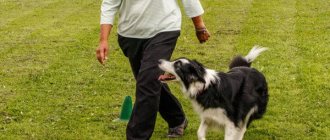At what age should you start learning?
Experienced dog trainers recommend starting to train skills from 2-4 months of age. It has long been noted: the younger the pet, the easier it is to train. An adult dog can also learn to bark on command, but training will take much longer and require more persistent effort.
There are “silent” breeds that occasionally voice: bullmastiff, mastiff, deerhound, Afghan hound, Chinese Shar-Pei, Rhodesian Ridgeback, Akita Inu.
All breeds of shepherd dogs, Labradors, and Chihuahuas easily learn to bark on demand. Before training those who like to talk and bark to their heart's content, for example, huskies, you need to think carefully about whether this is necessary. These breeds are also capable of learning to voice. But if the owner teaches and allows it, the husky will happily howl day and night, sing and howl.
The skill of giving voice on command is necessary primarily for service dogs:
- hunting - to track and catch prey;
- guard and shepherd dogs - to react to the approach or removal of a threat;
- search dogs, guide dogs - to detect an object, a person, to notify of danger.
When starting training, consider your pet's temperament. Phlegmatic, melancholic natures, especially in adulthood, are quite difficult to teach this exercise. The most amenable to training are inquisitive sanguine and choleric puppies, who constantly revolve around their owner, are interested in their surroundings, and like to play and run for a long time.
Training an adult dog
With proper training, you can learn a voice command with your dog, regardless of its age. However, you should be prepared for the fact that an adult animal will need a little more time to master the skill. Train him several times a day, use various rewards and training methods, and you will succeed.
When practicing this skill with an adult pet, take into account the characteristics of its breed. If you are training a hunting dog or bloodhound, you should practice barking repeatedly. If your pet is not one of these animals, you can teach him only a single voice.
Who will need this command and when?
Before you figure out how to teach a dog the “Voice” command, you need to familiarize yourself with the main purpose of this skill. It is most often used when working with service breeds. This group includes the following varieties:
- shepherds;
- security and sentry;
- search and rescue;
- hunting;
- wanted;
- guides.
With the help of barking, these animals scare away potential intruders, protect objects entrusted to them, notify about a sudden deterioration in the health of their owner, the appearance of prey, as well as the presence of prohibited substances, criminals or people injured under the rubble.
For all other pets, this skill is less important, but still useful. Small dogs are often notorious for barking, so conscious barking is an effective way to control their vocal behavior.
We are looking for an approach to the pet
An approach is necessary and this is logical, you can physically sit or lay down a dog while teaching the appropriate commands, making the dog bark when it is convenient for you is an impossible task. If you want to quickly teach your puppy a voice command, you will have to find his “Achilles heel” and take advantage of the weakness. Initially, in official understanding, the barking of a dog should mean:
- I found something - an object, a person, a smell, a game - for dogs with the makings for patrol and search work, hunting breeds.
- I see danger - the approach of a stranger, an object, intuitive orientation - guard breeds and guide dogs that sense an approaching attack of the owner or his wrong actions.
- Everyone should stand, the territory is under control - reaction to the approach or removal of a protected object - guard-protective, herding breeds.
Note! Claims about the existence of untrainable breeds are, to put it mildly, unfounded. Yes, there are breeds that remember a command from 1 time or from 10, but there are no untrainable dogs.
Training tactics are chosen based on the dog’s inclinations and the method of training. In a group, the pet will learn the “Voice” command much faster thanks to the “pack reaction” - one of the students completed the required task and received a reward, the rest saw and learned it. Practicing the “Voice” command at home is more difficult, and success will depend on the patience and perseverance of the owner.
Preparation
Teach your puppy the basic commands “no”, “fu”, “come”, “place”, “near”. On the first day of purchasing your pet, immediately train him to use the toilet. If the dog has honed his skills and immediately follows commands, teach him to use his “voice.” Preparation:
- For training, choose a quiet place, train the dog on the street and at home so that it follows commands in different conditions.
- Train 2-3 times in 7 days. At first, train for half an hour to 40 minutes. The dog will learn the lessons, after which increase the training time to 60 minutes.
- Periodically repeat teaching past tricks so that your pet does not forget them. Do not overload the dog, this will affect the poor learning of lessons.
- When learning to give a “voice”, pay attention to the intonation of the pronunciation of the command. Shout loudly and clearly. Don’t yell, but strictly say “voice.”
- Each executed command is rewarded with a treat. If the dog doesn't do the trick, don't give the cookie. He must understand why he is being rewarded. Stroke and praise your pet, this is important, just like a treat.
The dog will have a positive attitude towards you, will learn faster, and will perceive you as a leader.
Where to train
The training location is closely related to the training method and purpose. Service, hunting and guard dogs must be taught to bark on command in places of “duty” so that the dog simultaneously develops an understanding of the usefulness of the skill.
Tips from dog handlers
Before starting training, it is worth consulting with a professional who will give practical advice regarding the “student” of a particular breed. The following can be considered universal:
- The duration of the first workouts should be 15-20 minutes.
- You cannot force a dog using force or brute pressure.
- During classes, you need to monitor your pet’s well-being and mood.
- You cannot “beg” the puppy to carry out a command (it must be spoken only once).
A decorative dog can also be trained to vocalize on command.
There are no useless skills in dog training. Any teaching disciplines the pet and strengthens mutual understanding with the person. Even if the dog does not belong to the breeds for which the command “Voice!” necessary, he will happily spend time with the person. The main thing is that your four-legged friend is comfortable during classes.
Training methods
Interest will help in training - so that the dog is involved with food, resentment - a provocative action will encourage the dog to learn, imitation - call a friend who has a trained pet, eavesdropping - take advantage of the moment: give a command when the dog barks.
"Voice" command gesture
The trainer's stance is confident, feet shoulder-width apart. One arm is adjacent to the body, the second is bent at the elbow and is located in front of the chest. The palm is turned towards the dog, the thumb is turned inward. The hand swings from right to left without bending forward. Don't be confused! An arm bent at the elbow with a straight open palm, placed to the side at a right angle to the chest - this is the “Sit” command.
Note! The correct posture and gesture are required for each repetition of the command until complete mastery - the dog barks according to a voice order and a silent wave of the hand, always, without reservation.
Interest
At the beginning of training, interest the animal so that it has an incentive to learn. A tasty treat helps quickly accustom your pet to commands. Do not give cookies if the dog does not perform the trick. Form a rule for yourself - obedience and reward.
Show your dog the food and say the “voice” command. The dog cannot restrain himself and barks at you so that you give him food. In the future, do not show the meat, hide it behind your back, command it, and reward it after performing the trick.
If the dog jumps, tries to get a treat, interferes with training, tie a leash to it and train it. Instead of food, the reward will be a ball or an artificial bone for games. Reward a well-trained dog more with petting and praise than with treats. Then the pet will expect good words from you, and not consider the owner as an object for distributing food.
Irritation and resentment
Dogs are trained in this way to guard private property. Tie the dog to a peg on a chain, place an object next to it, call an assistant and let him imitate movements as if he wants to take away the protected object. But you can’t take the object away: you just need to show with chaotic movements that attempts are being made to take possession of the object. The pet barks at the assistant. Immediately give the “voice” command and reward with a treat. And the assistant should move away a little during the reward process.
A dog asking for a walk will bark. Get ready for a walk, take a leash, demonstrate that you will go outside without your pet. The animal will sit, and you will sternly shout “voice”; if the dog has fulfilled the requirements, then pet the pet, reward it with a treat and go for a walk with it. While walking, tie the leash to a tree and command “voice.” Your pet will bark, pet it and give it a treat. The provocation method helps train dogs.
Imitation
While walking, use a clever trick that helps encourage your dog to train. Invite a friend or friend with you for a walk with a dog trained in the “voice” command. Ask a friend to give the command to your dog “voice”, at this moment bring your pet so that he watches the experienced dog.
Repeat the training with your animal, order it to bark, if it doesn’t help, then again ask your partner to demonstrate the lesson, then order your pet to bark. If the trick is learned, then reward the four-legged dog with a treat.
Eavesdropping
Easy training for your pet involves eavesdropping. Go about your normal activities without paying attention to your pet; if he barks, then command “voice” and give him a treat. After doing a few tricks, the dog will learn the lesson, it may take a week or a couple of weeks. It all depends on the dog's intelligence. Do not follow the animal or follow on its heels to catch the moment of barking.
A well-trained dog can be considered one that executes commands at a distance of 15 meters from the owner. Do not allow several people to train your pet; the owner must do the training. Teach your dog not only to give a “voice”, but also to stop barking at the first request.
Food as the main incentive
As already noted, no incentive for a dog to perform the required actions compares with a treat. For the sake of food, a pet is capable of much. This characteristic feature of dogs can be successfully used for training.
Before starting the training itself, it is necessary to make certain preparations, namely, to secure the dog so that he cannot rise on his hind legs, much less jump. To do this, you can tie his leash to something, etc. Next you need to proceed like this:
- Show your pet a treat.
- Let your dog sniff the treat.
- Raise your hand with the treat up so that the dog cannot reach it. Simultaneously with this movement, command “voice”.
- Most dogs, finding themselves in such an outrageous situation, begin to bark. As soon as your pet gives a voice, you need to immediately praise him and give him the demonstrated treat.
Making classes more difficult
After the dog has begun to learn the ability to bark on command and understands what the owner expects from it by saying “voice,” you can complicate the command, achieving not just a single “Woof,” but three times or a continuous one. The training methods remain the same and differ only in the result you expect from the dog.
The listed methods are suitable not only for puppies, but also for adult dogs.
It is considered that the result has been achieved and the command has been learned when the animal responds to a command given by the owner at a distance of 15 meters. Achieve this by gradually replacing treats with praise, and also increasing the distance between you and the dog.
What does a voice command mean to a dog?
This skill allows you to control the animal’s barking and use it to suit the owner’s needs. It can be used in conjunction with another order, “Quiet,” after which the pet must immediately shut up. This skill is useful for various purposes: during rescue and search operations involving animals, and when tracking criminals.
Every dog can learn to vocalize on command. Animal owners should teach their pet to bark once or repeatedly (this is necessary for service breeds). The dog owner can cope with this task independently or with the help of an experienced trainer.
An approach to teaching the “voice” command depending on the dog’s psychotype
As you know, dog temperament is divided into the following types:
- Choleric is an active puppy, following its owner everywhere, preferring to skip feeding and stick its nose into something unknown.
- Sanguine is also an active dog, but able to take control of emotions at will. Optimal psychotype for training.
- Phlegmatic – thinking and weighing type. In training, monotony and frequent repetitions of the same command are not acceptable. Rewards do not play a special role; the pet needs to feel the significance of the process and the positive emotions of the trainer.
- Melancholic is a calm dog, preferring low activity, willingly following commands if it sees meaning in the “work”. Receiving praise and treats is not considered “meaningful”. It takes a lot of time to develop and hone commands.
Pets of the choleric and sanguine types are easiest to train to bark on command, just because the dog loves to bark. Melancholic and phlegmatic people, especially if we are talking about an adult dog, are quite difficult to make “dance to your tune.” If the pet perceives the uselessness of the command, even if you hit the wall, the animal will not follow the instructions clearly, only “in the mood.”
Note! Regular barking for no reason, often observed in choleric patients, is an indicator of a low level of training. The dog must know when it should and can bark.
Team training
Depending on the psychological characteristics, character, and preparedness of your animal, you can choose the optimal method that will be most effective. You can combine several learning methods.
Don’t forget to repeat the learned commands to consolidate the results!
Treat method
Using this method, choose the most desirable treat for your pet. Ideally, you should have a special treat that the dog receives only after correctly executed commands. Instead of a treat, you can use a separate toy that you are not allowed to play with at normal times.
Before you begin the exercise, make sure that the dog cannot jump up and grab the treat from your hands. You can step on the leash, preventing the animal from getting up on its hind legs. Raise the treat above the dog's face and say firmly and sternly, “Voice.” Most likely, the animal will not immediately bark. After this, praise the student and treat him with a tasty treat. Repeat the procedure several times. You should not repeat a command if the dog does not respond to it. Make sure that the reaction follows after pronouncing the command once.
Imitation method
If the training is not going well, you can invite a dog that has been trained in the “Voice” command to the lesson. The puppy will watch what is happening and see how you praise and treat your competitor. Most likely, he will also want to receive praise and will begin to repeat after the four-legged teacher. After the student successfully follows a command, treat him with a tasty treat, praise and pet him.
If among the dogs you know there is no one who could set an example for your pet, you can use a person. He will bark on command. This method makes you laugh, but it is very effective.
The methods listed above are the main ones, but other methods can be used. Observe your animal and find out what triggers its barking. Before you provoke your pet, give him a command and be sure to praise him.
Useful tips
To quickly and easily teach your pet a voice command, follow these recommendations:
- Monitor your dog and find out what most often causes him to bark. Use this during your training.
- Exercise with your pet several times a day. If you cannot spend time with the animal regularly, delegate the command to a relative. Remember that your pet must vocalize when requested by any member of your family.
- Learn the “Quiet” order first. You can use it to stop inappropriate barking.
- When training, be sure to use safe words. If your pet is acting out, command him “No” or “Fu”. Do this if he tries to snatch encouragement from you, jumps into your arms, or tries to run away.
- Remember that your activities should not tire the animal too much. Monitor the condition of your Spitz or pet of another breed. If he becomes lethargic, play with him. Otherwise, the animal will lose interest in practicing skills.
- Always say commands loudly and clearly. Your voice should be calm and firm.
- Stop training if your dog becomes overly active. This indicates that the animal is overexcited. Run around with him, play with toys. When your four-legged friend gets a little tired, he can continue training.
- Use incentives. During the first stage of training a Labrador or any other breed, you can use treats as a reward. After the dog has mastered the command completely, replace the treat with stroking and verbal praise. But never use them if your pet has not done what was asked of him.
- Watch how your dog behaves during training. If she is nervous and shows fear, it means you are being too strict with her. Change your training method and you will soon achieve success.
- If your puppy loses interest in the activity, take a break from practicing the skill. Play with his favorite toy. To provoke the animal, give it several commands that it already knows well and always carries out correctly (“Give a paw”, “Place”), be sure to treat it with its favorite treat. This will return your four-fingered friend's interest in training.
- Stay calm while practicing. Even if the animal fails to master the required skill after numerous attempts, do not show aggression towards it.
- If you want to train your puppy to bark multiple times, stick with the “Woof” bark three times. Longer commands should be handled by a professional trainer. If you train them at home, the dog will be overexcited during the training process, and it will be difficult for you to limit his barking to 4 or 5 sounds.
How to teach a puppy a voice command?
Before starting training with a pet, the owner should choose a quiet, secluded place for training, and also take care of rewards for the dog. Animal training can be done both outdoors and at home. It is important to train your dog systematically. Dedicate to this at least 3 days a week. At first, you can exercise with your pet for 30-40 minutes, then increase the duration of training to an hour.
At the beginning of the lesson, put a leash and collar on your dog. Start training him like this:
- Make sure there are no distractions for the animal. Take a piece of food, show it to the dog, let him smell it.
- When the animal wants to eat a treat, you need to raise your hand with the treat up and give the command “Voice”.
- Make sure your puppy doesn't take food out of your hands. To prevent him from jumping onto your lap, use your foot to press his leash to the floor.
- If the animal gives a voice, immediately give it a treat.
Following the command may cause difficulties for your pet. What to do in this case? You can show your dog how other animals practice this skill. Your pet should see an adult dog voice several times and receive encouragement for this. Only in this case will the puppy understand what they want from him.
If you do not have the opportunity to show your pet how other animals train, use an alternative method. Follow him, as soon as he starts barking, command “Voice” and give him a treat. Do this several times, and the desired skill will be reinforced. Just make sure that the puppy receives food only after barking on command, otherwise he will do this constantly. In the same way, you can wean him from frequent barking for no reason.
At first, give the command 2-3 times in a row. Once your animal begins to follow it completely, reduce the number of orders to one. If your pet immediately starts barking, wait a few seconds. This way the dog will learn that it is necessary to follow the owner’s orders the first time.
For animals that have mastered the skill, the task can be made more difficult. Get them to vote three times. It's not difficult to do. It is enough to repeat the command three times during training and give a treat only after the puppy says “Woof” three times. If your dog is involved in search work, you can train it to vocalize 4, 5, 6 times. For an ordinary pet, such training is not necessary.
Adult dog
With proper training, you can learn a voice command with your dog, regardless of its age. However, you should be prepared for the fact that an adult animal will need a little more time to master the skill. Train him several times a day, use various rewards and training methods, and you will succeed.
When practicing this skill with an adult pet, take into account the characteristics of its breed. If you are training a hunting dog or bloodhound, you should practice barking repeatedly. If your pet is not one of these animals, you can teach him only a single voice.
Video: how to teach a dog a voice command at home?
Errors in learning
The main mistake is rewarding the dog while barking without saying the “Voice” command. If the puppy wants to talk, let him bark for good measure, don’t praise him for it.
When training a dog to accidentally bark, owners often make the mistake of not turning attention to themselves. In this case, the animal may develop a reflex of praise for aggressive behavior.
The call to bark is repeated many times when the skill is established. At first, until your pet learns the exercise well, you will have to repeat the voice command more than once. But as soon as the skill has appeared, you should pronounce the order 1 time clearly and confidently.
It is also forbidden to speak irritably or hit the dog with your hands, leash, or collar.
Another mistake: forcing the animal to bark many times. There is no need to force you to repeat the same thing: do other exercises from those you have already learned, switch your attention.
Doing training on a playground with dogs playing with balls and other toys is a bad idea. Your pet is a pack animal that loves to imitate its fellows, remember and use this feature when training. Other dogs nearby who are doing the same thing and are more developed and trained will help you effectively consolidate your skills.
The lessons will be successful if the pet and the owner are in a good mood, then the exercise will be perceived as a fun game.
The main thing is to treat your four-legged friend with patience and attention, then he will respect you and delight you with his obedience.










